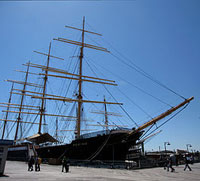 German media is reporting that sometime next spring, the historic Laeisz Flying P-Liner Peking is expected to leave New York harbor, where she has been a museum ship at the South Street Seaport Museum for over 40 years. She will be returning to her home port of Hamburg, where she was built, 105 years ago. In no condition to travel on her own bottom, the grand old windjammer will be carried across the Atlantic on the deck of a heavy lift ship. Prior to her trans-Atlantic passage, she will move from the South Street Seaport to a local shipyard to be made ready for the voyage.
German media is reporting that sometime next spring, the historic Laeisz Flying P-Liner Peking is expected to leave New York harbor, where she has been a museum ship at the South Street Seaport Museum for over 40 years. She will be returning to her home port of Hamburg, where she was built, 105 years ago. In no condition to travel on her own bottom, the grand old windjammer will be carried across the Atlantic on the deck of a heavy lift ship. Prior to her trans-Atlantic passage, she will move from the South Street Seaport to a local shipyard to be made ready for the voyage.
The Peking‘s new owner is the Hamburg Maritime Foundation. The ship will be part of the a new Hamburg maritime museum, which is under construction.
On August 26th, as part of their “Free Fridays” program, the South Street Seaport Museum will be honoring the Peking with participatory sail-raising aboard the barque, printing demonstrations at Bowne Printers with Peking themed take-aways, and a special screening of Around Cape Horn. Click here to register for the screening.
The four-masted steel-hulled barque Peking was built in 1911 at the Blohm & Voss shipyard in Hamburg for the German ship owner, F. Laeisz. Laeisz operated a series of sailing ships whose name began with the letter P, which were know as the Flying P Liners. They were among the last generation of windjammers used in the nitrate trade and wheat trade around the often treacherous Cape Horn.
Peking made voyages from Europe to the west coast of South America with general cargo and returned filled with nitrates for use in the making of fertilizer and explosives. The windjammer was made famous by the Irving Johnson film Around Cape Horn which documented her 1929 passage around the southern tip of South America in hurricane conditions.
After 1933, the Peking served as the school ship, Arethusa II, mooring on the River Medway in Great Britain. She was purchased as museum ship by the South Street Seaport Museum in 1975.
Remarkably, including Peking, four of the original Flying-P Liners survive today. The Pommern is a museum ship in Mariehamn, Finland. The Passat is a museum ship in Lübeck’s sea resort Travemünde, Germany and the Padua, renamed Kruzenshtern, is still sailing as a school ship under the Russian flag.

A “voyage” indicates an ocean round trip. A one way ocean trip is a “passage”. I seriously doubt this ship will return to NYC. Good day.
The conventional dictionary definition of voyage is “a long journey involving travel by sea or in space.” No round trip required.
For anyone in the NYC area and has the interest, the S. St Seaport Museum issued a press release for the final departure of the Peking from its berth at Pier 15 at the base of Fulton St on the East River in Lower Manhattan on 9/6:
https://southstreetseaportmuseum.org/wp-content/uploads/2016/08/Peking_PR.pdf
There was a screening Friday (8/26) of the 1929 amateur documentary of the Peking on one of its nitrate-hauling trips to Chile, requiring passage around the Horn, filmed and narrated by Capt Irving Johnson.
Perhaps the greatest 30 mins of footage of what sailing such an enormous ship through waters as treacherous as these required.
Available via Mystic Seaport or Amazon. See some of the film reviews:
https://www.amazon.com/Around-Mystic-Seaport-Museum-Presentation/dp/B000VPTIBQ
A WSJ photographer accompanied the last visitors allowed to board the Peking last Sunday, and a nice slideshoe of what things look like below deck was posted to their site:
http://www.wsj.com/articles/the-pekings-last-visitors-1472426894
(if you encounter a paywall ‘gray-out’, Bing: ‘The Peking’s Last Visitors’ and ‘WSJ’, and you should get the link).
Hi, was just reading about the “Peking” getting ready to leave NY for Hamburg. As an Ex Arethusa boy I was reading the comments when I noticed a question posed ny Michael Peter Greene (157) We both joined the same day and I haven’t had contact with him for over 56 years. Can you pass on my email address to him (les.langford@gmail.com) so that he could contact me please.
When I sailed as deck hand on the yacht “Stella Polaris” out of Chicago in 1952, The “Mate” who hired me was Charles Hanson, known as “Tattoo Charlie”. He used to tell stories of his younger days sailing on the “P” ships from Europe before WW2. He was a Swede “square rigger” sailor and had tattoo’s completely covering his upper body. Beginning of WW2, he was on a sail yacht in the US and remained here working as a shipyard rigger. Then, back to yachts, and finally at a yard on New York’s City Island.